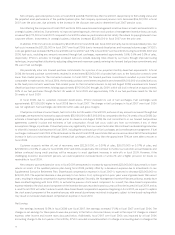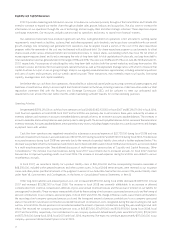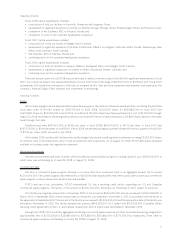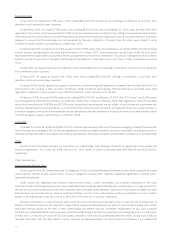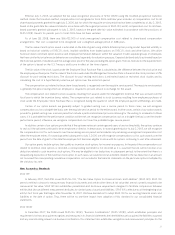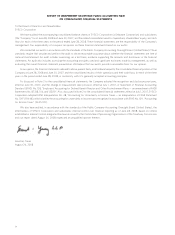Sysco 2008 Annual Report Download - page 50
Download and view the complete annual report
Please find page 50 of the 2008 Sysco annual report below. You can navigate through the pages in the report by either clicking on the pages listed below, or by using the keyword search tool below to find specific information within the annual report.when it is more likely than not that the position will be sustained upon examination, including resolutions of any related appeals or litigation
processes, based on the technical merits of the position. The amount recognized is measured as the largest amount of tax benefit that is
greater than 50% likelihood of being realized upon settlement. (See discussion under Note 16, Income Taxes, in the Notes to Consolidated
Financial Statements in Item 8).
Our liability for unrecognized tax benefits contains uncertainties because management is required to make assumptions and to apply
judgment to estimate the exposures associated with our various filing positions. We believe that the judgments and estimates discussed
herein are reasonable; however, actual results could differ, and we may be exposed to losses or gains that could be material. To the extent we
prevail in matters for which a liability has been established, or pay amounts in excess of recorded liabilities, our effective income tax rate in a
given financial statement period could be materially affected. An unfavorable tax settlement generally would require use of our cash and may
result in an increase in our effective income tax rate in the period of resolution. A favorable tax settlement may be recognized as a reduction
in our effective income tax rate in the period of resolution.
Vendor Consideration
We recognize consideration received from vendors when the services performed in connection with the monies received are completed
and when the related product has been sold by SYSCO. There are several types of cash consideration received from vendors. In many
instances, the vendor consideration is in the form of a specified amount per case or per pound. In these instances, we will recognize the
vendor consideration as a reduction of cost of sales when the product is sold. In the situations where the vendor consideration is not related
directly to specific product purchases, we will recognize these as a reduction of cost of sales when the earnings process is complete, the
related service is performed and the amounts realized. In certain of these latter instances, the vendor consideration represents a
reimbursement of a specific incremental identifiable cost incurred by SYSCO. In these cases, we classify the consideration as a reduction
of those costs with any excess funds classified as a reduction of cost of sales and recognize these in the period in which the costs are
incurred and related services performed.
Accounting for Business Combinations
Goodwill and intangible assets represent the excess of consideration paid over the fair value of tangible net assets acquired. Certain
assumptions and estimates are employed in determining the fair value of assets acquired, including goodwill and other intangible assets, as
well as determining the allocation of goodwill to the appropriate reporting unit.
In addition, annually or more frequently as needed, we assess the recoverability of goodwill and indefinite-lived intangibles by
determining whether the fair values of the applicable reporting units exceed the carrying values of these assets. The reporting units used in
assessing goodwill impairment are our six operating segments as described in Note 19, Business Segment Information, to the Consolidated
Financial Statements in Item 8. The components within each of our six operating segments have similar economic characteristics and
therefore are aggregated into six reporting units.
We arrive at our estimates of fair value using a combination of discounted cash flow and earnings multiple models. The results from
each of these models are then weighted and combined into a single estimate of fair value for each of our six operating segments.The primary
assumptions used in these various models include estimated average sales and earnings multiples of comparable acquisitions in the
industry, average sales and earnings multiples on acquisitions completed by SYSCO in the past, future cash flow estimates of the reporting
units and weighted average cost of capital, along with working capital and capital expenditure requirements.
Actual results could differ from these assumptions and projections, resulting in the company revising its assumptions and, if required,
recognizing an impairment loss. Our past estimates of fair value for fiscal 2007, 2006 and 2005 have not been materially different when
revised to include subsequent years’ actual results. SYSCO has not made any material changes in its impairment assessment methodology
during the past three fiscal years. We do not believe the estimates used in the analysis are reasonably likely to change materially in the future
but we will continue to assess the estimates in the future based on the expectations of the reporting units. In fiscal 2008, the reporting units’
fair values would have had to have been lower by 20% compared to the fair values estimated in our impairment analysis before additional
analysis would have been indicated to determine if an impairment existed for any of our reporting units.
The Other (specialty produce, custom-cut meat, lodging industry products and international distribution operations) operating
segments have a greater proportion of goodwill recorded to estimated fair value as compared to the Broadline or SYGMA reporting units.
This is primarily due to these businesses having been recently acquired, and as a result there has been less history of organic growth than in
the Broadline and SYGMA segments. In addition, these businesses also have lower levels of cash flow than the Broadline segment. As such,
these Other operating segments have a greater risk of future impairment if their operations were to suffer a significant downturn.
Share-Based Compensation
We provide compensation benefits to employees and non-employee directors under several share-based payment arrangements
including various employee stock incentive plans, the Employees’ Stock Purchase Plan, the Management Incentive Plan and various non-
employee director plans.
26


